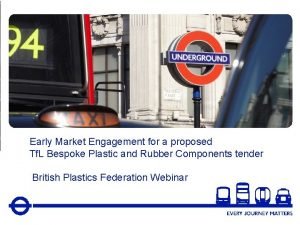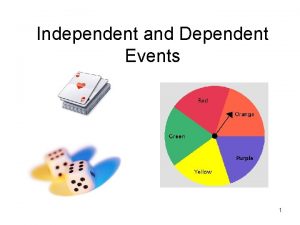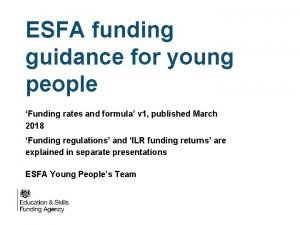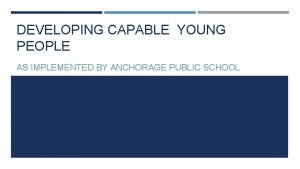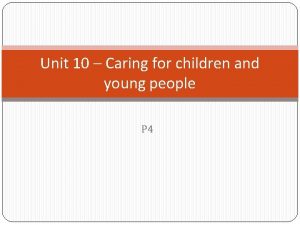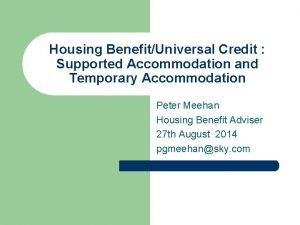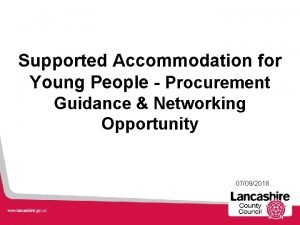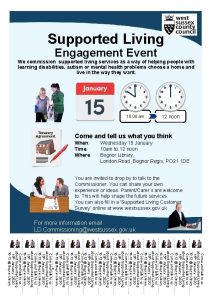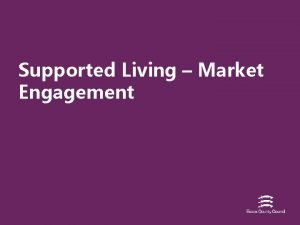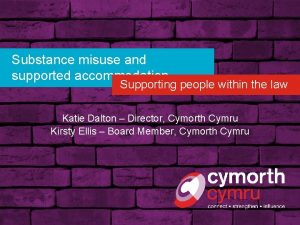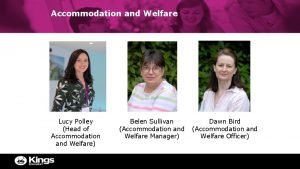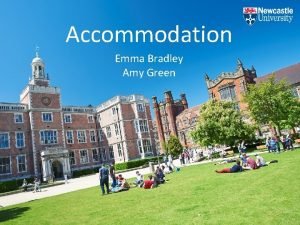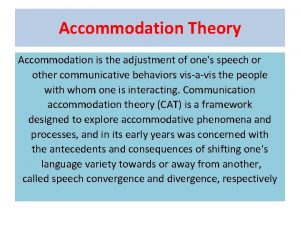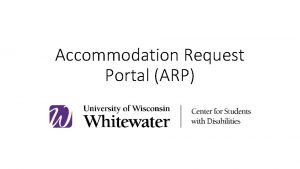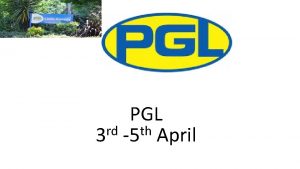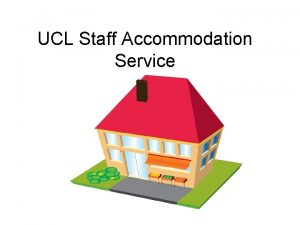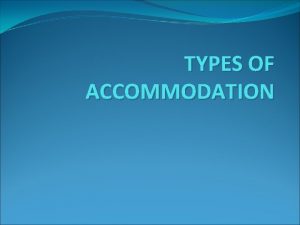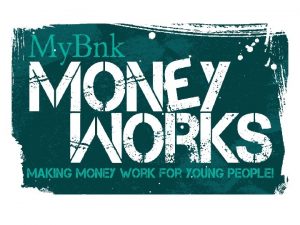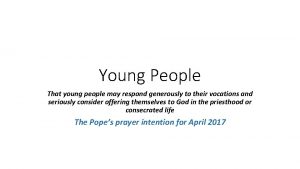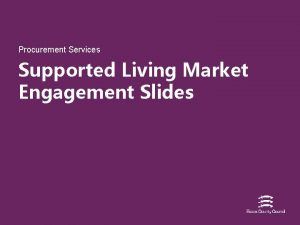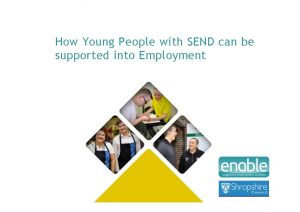Market Engagement Event Supported Accommodation for Young People













































- Slides: 45

Market Engagement Event Supported Accommodation for Young People 7 th September 2018 The Savoy Suite, County Hall, Preston

2. Context Setting & Demand Overview

Background • Historically two budgets – Supporting People (SP) & Leaving Care - held in separate Service areas of the organisation (SP for young people sat alongside the wider SP support services, Leaving Care with Children’s Social Care Service) • The SP budget was reduced from 2016/17 to initially meet statutory duties • Cabinet approval obtained to bring SP funding together with leaving care funding and to review the access arrangement to block contracted SP services to give priority to young people to whom the Council has a statutory duty • Commissioning is via existing block contract arrangements or through the regional North West Dynamic Purchasing System (DPS) • Utilising block purchased provision is a key commissioning priority set out in the Authority's Children Looked After Sufficiency Strategy approved by Cabinet in October 2017 • The Access to Resources Team is the centralised placement function for 16+ supported accommodation needs

Reasons for service re-design • Contracts for block contracted services will end in June 2019 – opportunity for a Lancashire to establish a single procurement arrangement for supported accommodation for YP aged 16+ • A more consistent service offer across the county is needed – particularly move on • Models of best practice nationally adopt a more flexible service delivery model where YP can more fluidly move between varying levels of support according to changing need. No linear relationship between accommodation types and the support YP need • Opportunity to work closer with providers to address gaps in provision – can our existing in-house services work more collaboratively with providers? • Budget pressures – deliver best outcomes and achieve value for money: - Block purchase of individual placements for ‘predictable demand’ to reduce fees - Fees more directly linked to need for some service types?

Barnado’s & St Basil’s Accommodation & Support Framework A key principle is YP being able to make mistakes and never ‘falling out’ of the framework

Other accommodation / support options Ø Training / taster flats Ø House share options (eg. St. Vincent’s Snug. Bug Houseshare) Ø Peer or ‘lead’ landlord schemes Ø Peer mentoring

Current Block Contract Provision Ø 249 units of core, short term and move on (detailed on the next slide) Ø Dispersed supported accommodation – 85 units in East Ø Supported Lodgings – 9 North, 13 East Ø Supported accommodation for teenage parents – 9 East, 6 Central Ø Some shared family and young people services

Current Block Contract Provision Core, move on, crisis District Burnley Pendle Rossendale Hyndburn Ribble Valley Preston Chorley South Ribble West Lancashire Fylde No. Unit types buildings Units 3 1 1 2 2 5 1 1 22 19 14 11 7 27 18 29 10 12 Lancaster 4 47 Wyre 3 33 249 18 x 1 -bed self contained, 4 bedsits in a shared house 15 x 1 -bed self contained, 4 en-suite emergency rooms 3 x 1 -bed self contained, 6 en-suite units, 5 emergency room shared facilities 6 x 1 -bed self contained, 5 rooms shared facilities 7 x 1 -bed self contained flats 16 x 1 -bed self contained, 11 units in a shared house 18 x 1 -bed self contained flats 23 x 1 -bed self contained, 6 units in a shared house 10 x units in shared accommodation, some with more self contained features 12 x 1 -bed self contained flats 5 x 5 -bed cluster flats, 2 x 2 -bed shared flats, 7 x units in shared house, 7 x 1 bed self contained flats 24 x 1 -bed self contained flats, 9 x shared units

DPS Provision • 23 of the 94 group living settings are within LCC administrative boundaries (12 districts) • Supply of group living provision is contained to limited parts of the county: Burnley (7), Accrington (2), Preston (8), Morecambe (4), Fleetwood/Lytham (2) as presented on the map below • At 31 st March 2018 LCC were commissioning c. 45 placements in group-living (3+ bed) settings • Due to location constraints placements in group living settings will not always be in the preferred location for the YP • Floating support with accommodation, 33 DPS providers – for LCC, predominantly commissioned in the East of the county

DPS Provision – Group Living locations

Current Demand Block contracted services: • High utilisation of the core & move on schemes – most schemes had nil or one vacant unit at end of Qtr 1 • Includes 31 looked after children at 31 st July 2018 DPS commissioned placements: • 98 placements of looked after children at 31 st July 2018

Challenges to predicting future demand • Rising CLA numbers (overall, and the proportion in supported accommodation) Number of Looked After Children Jul-18 Mar-18 Dec-17 Sep-17 Jun-17 Mar-17 Dec-16 DPS or off-contract 98 90 84 85 65 61 50 Block contract 31 19 17 15 7 1 3 Total CLA in supported 129 101 100 72 62 53 accommodation Total no. CLA 2, 051 1, 968 1, 951 1, 921 1, 876 1, 864 1, 816 In supported as % of total 6. 30% 5. 50% 5. 20% 3. 80% 3. 30% 2. 90% • Impact of prioritisation criteria for access to services • Trends – needs to be analysed at district level • Level of need – how to predict based on a wide range of presenting needs & how it translates to appropriate supported accommodation • Location – known based on where actually placed / CSC district team a YP is allocated to but doesn’t necessarily indicate preferred location • Data quality – accuracy of recording

3. Service User Outcomes & Service Design Objectives

Service User Outcomes In addition to any specific needs identified in the young person’s individual Care Plan/ Pathway Plan, the provider will work to support the young person to achieve the following outcomes: Ø Ø Ø Ø Promoting Health and Wellbeing Stay Safe Relationships Identity Enjoy and Achieve Promoting Participation Promoting Independence

Service Design Objectives 1. Prevent homelessness 2. Sufficient emergency accommodation is available to meet need if homelessness cannot be prevented A range of appropriate housing and support options are available for care leavers to move on to in a planned way 3. 4. The geographical location of services enables young people to be able to maintain links with family, friends and college 5. Services are available for young people with a range of needs including individuals with complex needs, teenage parents, pregnant young people, offenders. Services meet the cultural needs of young people. 6. The level of staffing within services and the knowledge, skills and values of staff meet the needs of the intended client group 7. Young people are able to move on from services at an appropriate time to a suitable setting 8. Services deliver value for money

4. Provider Consultation Feedback

Consultation with Providers Responses Received • A total of 7 responses received from block contracted services including 1 collective response from 5 providers • A total of 4 responses received from providers on the North West Care Leaver and Young Homeless Supported Accommodation Dynamic Purchasing System (North West DPS)

Consultation with Providers: Service Design / Tender Process / Issues • • • • Need consistent service offer/range of provision across Lancashire Importance of move on – currently there are inconsistencies across Lancashire More 16/17 year olds has led to greater front line support and management support being required Importance of strategic links and commitment: from housing regarding move on and DWP regarding benefits Funding of short term interventions/top up service Consider low priority groups if proven prevention link Increased provision of advocacy Evaluation should be focussed on quality – savings will be made via appropriate use of SA Longer contracts Contracts should be outcome focussed (i. e. not hours based) Young people should input into design Total contract sum should be enough to support people with high needs flexibly Address operational issues including communication between social workers and providers, holistic assessments, reviews

5. Young People Consultation Feedback

Consultation with Young People To inform future provision it has been essential to engage and consult with young people. An on-line questionnaire was completed by 76 young people living in supported accommodation. A summary of the results has been shared with the agenda. In addition, to date we have met with young people to seek feedback at: Ø Ø Young people’s focus group- comprised of 8 young people currently residing in supported accommodation East Lancashire Care Leaver Drop In – 5 YP Care Leaver Apprentice Group – 6 YP Care Leaver Local Offer event- supported accommodation focus – 30 YP

Young People Focus Groups • Young people: – have engaged in more informal discussion groups to discuss supported accommodation – have attended from a range of accommodation types in ‘young people friendly’ settings and at times that are suitable for them – were encouraged to be open and honest and to share ideas for improvements to accommodation and support • Their views broadly mirror feedback from the online survey • Additional consultation and engagement will take place throughout the planning stages of recommissioning supported accommodation and as part of ongoing monitoring processes to be introduced to new contracts

Young People Focus Groups – Key findings Accommodation Young people were generally happy with their accommodation. However, • They would like improvements made more quickly- including fixing broken furniture, decorating, improved communal areas • In general, they are happy with the location of accommodation Support • Young people reported an increase in confidence • Better equipped to move towards independence • Support workers are approachable and helpful Recommended Improvements • Young people were keen to emphasise the need for more preparation for independence • More flexibility regarding communal facilities. E. g. use of washers/ driers/ communal gardens for guests/ • More relaxed approach to sleeping out/ curfew hours • More useful house meetings Young people will continue to be involved in the planning of service provision and will be consulted with about how this can best be done.

Young People On-line Questionnaire The online questionnaire was published for 3 weeks and promoted to all young people in supported accommodation. 76 young people responded and the results below illustrate the responses. Thinking about the building you live in, including your room. What are the best things about the accommodation you live in? Furnishings- 33 Independence- 13 Staff and support- 23 Feeling safe-9 Size-9

Young People On-line Questionnaire Thinking about the building you live in, including your room. What needs improving about the accommodation you live in? Decoration/ furniture- 40 Nothing- 17 Communal areas- 3 What are the best things about the support you receive in the accommodation where you live? Support / staff- 52 Learning life skills-12

Young People On-line Questionnaire What could be improved about the support you receive? Nothing- 50 More support- 5 Learning life skills- 6 Is there any other support that you would like to receive? No- 48 Staff support- jobs and money- 6 Staff support- moving on- 3

6. Future Proposals

Procurement Arrangements A Dynamic Purchasing System (DPS) has been chosen, to allow: Ø Ø Ø Ø A wide range of services to be commissioned through one procurement exercise with a single approach to quality and standards The ability to commission on different ‘footprints’ for different services Block contracts and spot purchase call offs Flexibility for LCC to commission additional services to meet changes in demand New providers to join at various points throughout the lifetime of the DPS Existing providers to apply for additional lots to respond to need The option for different pricing to be built in where appropriate No fixed duration or value for the overall DPS

Proposed Service Model Overview To award under the following contract types: Ø Ø Ø Block contracted services – ‘District’ based (grouped to 9 districts) Block contracts for a specified number of bednights for individual placements - Locality based (3 localities) Spot contracts on a call-off basis – countywide It is our intention that accommodation settings will be within the Lancashire County Council administrative boundaries (12 districts)

Proposed Service Model Service categories The following service categories will be in scope: Contracts to be assigned Service Type Contract Type Core support services – accommodation based. Block contracted services - District based Single per district Service Type Description Multi-occupancy, typically 10+ beds FSWA – Community based accommodation services sourced by providers and with floating resettlement support, supported by one to one staffing of varying levels. Typically sole occupancy. There may be the option for YP to take on the tenancy. Move-on – accommodation based, including: a) Floating support with accommodation (FSWA) b) Dispersed supported accommodation Block contracted services - District based Single per district Emergency accommodation Block contracted services - District based Single per district Crisis beds (time-limited support, to be defined) Group living / semi independent – accommodation based Block contract a specified number of bednights for individual placements - Locality based Single per locality Multi-occupancy, typically 3 -4 bed settings. The core contract is a package of support and accommodation for an individual placement Floating support Spot contracts for hours - Locality based Multiple Community based services providing floating/resettlement support (charged hourly) to enable young people to live semi independently in their own general needs accommodation Supported Lodgings Support for the model. Discussions taking place in relation to service delivery options YP has own bedroom with a host family and experiences domestic life in a shared and supportive environment. The YP is accommodated as a lodger, and receives support from the host family Teenage Parents Support for the model. Discussions taking place in relation to number of units / locations Accommodation based support specific to young parent(s) cohort Solo 24/7 Spot call off basis Bespoke package of support for the more vulnerable, complex, challenging YP Dispersed – As above for FSWA but typically 2 YP share and move on from the property into independence eg in RSL / private rented accommodation Multiple

Proposed Service Model 9 -District Footprint

Proposed Service Model 3 -Locality Footprint

Proposal for the block purchase for a specified number of bednights The proposals are as follows, and views will be sought in the group discussion: Ø LCC will be purchasing a specified number of bednights per annum for individual placements, across any settings the provider has named on the DPS Ø The full tendered rate will be paid by LCC for the specified number of bednights per annum Ø Providers and social workers will liaise with regards to most appropriate match. Further guidance will be developed to agree placement offer criteria Ø A target % utilisation of bednights will be set and monitored under the contract Ø In the event of under-utilisation (over a duration to be determined) an action plan will be agreed between LCC and the provider to increase utilisation Ø Under-utilisation over a sustained period of time will be addressed under formal contract terms Providers will be formally notified of a separate consultation specific to this proposal

Proposed Service Model Spot contracts on call-off basis

Proposed Service Model Accommodation options For the initial tendering of block accommodation-based support contracts, in terms of accommodation there a number of options including: Ø The building is specified by LCC at Invitation to Tender stage – providers bid to deliver support services within the named setting Ø The support provider sources accommodation – the accommodation forms part of the provider’s bid to deliver support services Ø LCC undertake a selection process inviting landlords to put forward suitable available accommodation – LCC would have the option to: Ø Select accommodation that is then named in the ITT for the support service; Ø Name all accommodation options that meet the required standards in the ITT for the support service

Referral Process • Block contracted services - Providers allocate properties according to agreed priorities and referral process • Block bednights for individual placements -referral by ART for individual placement to locality provider. Provider and social worker assess most appropriate setting • Spot contract – referral by ART for individual placement (call off from DPS/countywide lot). Offers are considered by Social Workers in order to identify the most appropriate

Block Contracted Services - Who Can Refer? • All 12 district councils within Lancashire • Lancashire County Council's Access to Resources Team and Emergency Duty Team (EDT) • VCFS service providers - where an agreement has been established between the VCFS provider and the district council regarding the service to be delivered by the provider on behalf of the district council • Supported housing providers who are seeking to move existing clients on to other services in order to enable them to step down to less intensive support, or where an individual is required to move to another setting which is better able to meet their needs

Eligibility and Prioritisation for Block Contracted Services • Priorities complex owing to legal status • Document circulated • Summary (refer to link on next slide) Ø High Priority: 16 and 17 year olds Ø Medium Priority: 18 – 21 year olds who have been previously known to social care or 18 -24 if formerly relevant Ø Low priority: 18 – 21 who have not been previously known to social care or 18 -24 if qualifying care leaver status (56 days)

Block Contracted Services - Access Arrangements Joint protocol - Meeting Needs of Homeless Young People http: //www. proceduresonline. com/lancashirecsc/p_homeless. html Group Discussion – we will consider the appropriateness of the eligibility and referral routes into block contracted services.

Quality Standards • Drawing on the existing SP QAF and North West DPS to develop quality requirements • Will include as a minimum: Ø Ø Ø Ø Safeguarding Recruitment/Workforce Health and Safety Risk and Needs Assessment and Support Planning Equality and Diversity Engagement, choice and control, rights and responsibilities Partnership working

Outcomes Taken from Existing NW DPS; however very similar to SP outcomes as they were based on Every Child Matters: Ø Ø Ø Ø Promoting Health and Wellbeing Stay Safe Relationships Identity Enjoy and Achieve Promoting Participation Promoting Independence

Quality Assurance and Performance Management Performance Returns • Probably quarterly • Activity Data – who is moving into services? • Outcome Data – outcomes for service users • Utilisation Visits to Services • Frequency still to be determined • Policies and Procedures • Service user engagement • Staff engagement • Case files

Contract Issues • Block contracted services - payments will be four weekly in arrears • Block contracted services – likely to have 6 month break clause plus normal provisions relation to defaults • Hours based? Outcome based? Provider feedback to consultation. To be considered in group discussion

8. Group Discussions

Group Discussion In terms of the 9 -District delivery model. What are your views on: Ø the service types that are proposed on this footprint? Ø a single contract per district? Ø how move-on can best be facilitated, particularly in areas where local housing stock is more limited ? Ø how emergency provision can best be delivered? In terms of the 3 -Locality delivery model for block purchase of a specified number of bednights for individual placements, for YP with higher level of need or risk than can be met through core block contracted services. What are your views on: Ø whether block purchase is appropriate? Ø whether a single contract per locality is appropriate? Ø what LCC need to give consideration to from a provider perspective?

Questions We would like to hear your views in relation to the following: Ø the service outcomes Ø the service design objectives Ø contracts which are outcome focussed and not hours based – how would this work? Ø accommodation options Ø the eligibility and prioritisation for block contracted services Ø the referral routes for block contracted services Ø quality standards Ø quality assurance and performance management Ø payments - could a payment by result approach be applied to any of the service types?
 Leader challenger
Leader challenger Segmentation levels
Segmentation levels Early market engagement
Early market engagement Sentinel event list
Sentinel event list Compound probability
Compound probability Independent event vs dependent event
Independent event vs dependent event Dependent events examples
Dependent events examples Event management content
Event management content Peta konsep news item
Peta konsep news item Town contaminated moscow
Town contaminated moscow This is only for young people
This is only for young people Esfa funding guidance
Esfa funding guidance The period of activism 1970 to 1972
The period of activism 1970 to 1972 Developing capable young people
Developing capable young people Where have all the young people gone
Where have all the young people gone Unit 10 caring for children and young people
Unit 10 caring for children and young people Tim too many young people are
Tim too many young people are Fspos vägledning för kontinuitetshantering
Fspos vägledning för kontinuitetshantering Typiska novell drag
Typiska novell drag Nationell inriktning för artificiell intelligens
Nationell inriktning för artificiell intelligens Ekologiskt fotavtryck
Ekologiskt fotavtryck Varför kallas perioden 1918-1939 för mellankrigstiden
Varför kallas perioden 1918-1939 för mellankrigstiden En lathund för arbete med kontinuitetshantering
En lathund för arbete med kontinuitetshantering Särskild löneskatt för pensionskostnader
Särskild löneskatt för pensionskostnader Vilotidsbok
Vilotidsbok Anatomi organ reproduksi
Anatomi organ reproduksi Förklara densitet för barn
Förklara densitet för barn Datorkunskap för nybörjare
Datorkunskap för nybörjare Stig kerman
Stig kerman Tes debattartikel
Tes debattartikel Delegerande ledarstil
Delegerande ledarstil Nyckelkompetenser för livslångt lärande
Nyckelkompetenser för livslångt lärande Påbyggnader för flakfordon
Påbyggnader för flakfordon Arkimedes princip formel
Arkimedes princip formel Svenskt ramverk för digital samverkan
Svenskt ramverk för digital samverkan Bo bergman jag fryser om dina händer
Bo bergman jag fryser om dina händer Presentera för publik crossboss
Presentera för publik crossboss Teckenspråk minoritetsspråk argument
Teckenspråk minoritetsspråk argument Kanaans land
Kanaans land Klassificeringsstruktur för kommunala verksamheter
Klassificeringsstruktur för kommunala verksamheter Fimbrietratt
Fimbrietratt Bästa kameran för astrofoto
Bästa kameran för astrofoto Cks
Cks Lågenergihus nyproduktion
Lågenergihus nyproduktion Mat för unga idrottare
Mat för unga idrottare Verktyg för automatisering av utbetalningar
Verktyg för automatisering av utbetalningar


